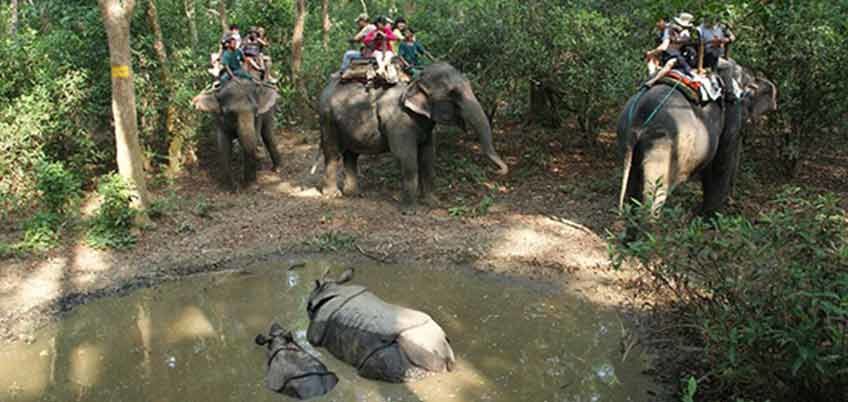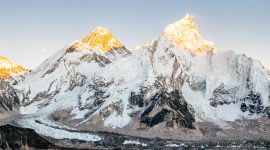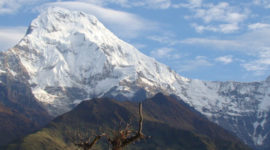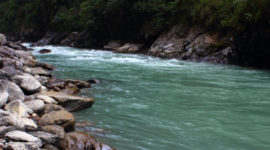
National Parks : Explore the wilderness of Nepal
19/Aug/2016 | by mokshaNational Parks: Explore the Wilderness of Nepal
Owing to the multitude of topographical variances over a small area, Nepal holds myriads of flora and fauna. This can also be attributed by the fact that the altitude in the country ranges from 67 meters to 8848 meters. In the diversity of 11 bio-climatic zones, 1,120 species of non-flowering plants and 5,160 species of flowering plants have been recorded. Also, 181 species of mammals, 844 species of birds, 100 species of reptiles, 43 of amphibians, 185 of freshwater fish and 635 of butterfly have been recorded. The biodiversity in the country has been protected under National Parks, Wildlife Reserves, Conservation Areas, Hunting Reserves and Wetland (Ramsar) Sites.
Here, we list the National Parks in Nepal that preserve many endangered species of flora and fauna.
Chitwan National Park (932 sq km)
Among the oldest National Parks and also under the World Heritage Site list, Chitwan National Park in Terai plains (South-Central) boasts 43 species of mammals which includes the rare one-horned rhinos, tigers, crocodiles, wild elephants, gaur, striped hyena etc. The park is home to above than 450 species of birds and 45 species of reptiles and amphibians. Chitwan National Park can best be explored on an elephant or a jeep ride through bird watching and jungle safari tours.
Sagarmatha National Park (1,148 sq km)
Sagarmatha National Park is located in the Khumbu region which bears its significance to the presence of Mount Everest and several other peaks including Lhotse, Cho Oyu and Nuptse. The wildlife in this park includes the Himalayan Tahr, goral and musk deer. Rarely seen wild animals include snow leopard, Himalayan black bear, langur monkey, weasel and Himalayan mouse hare. Trips to this National Park includes treks to the Everest Base Camp and High Passes, Island Peak trek, Dudh Kunda Trek and many others that take you through glacial valleys and mountain adventure.
Langtang National Park (1,710 sq km)
Home to varied wildlife such as red panda, musk deer, Himalayan tahr, langur etc, this park sees the blooming of several species of rhododendron in the spring and includes vegetations ranging from subtropical to alpine. Some ethnic groups living in the park can also be found in small villages along the way. The Tamang Heritage Trek, Langtang Helambu Trek, Ganja La Pass Trek and Langtang Valley Trek all are excellent options to explore this park.
Rara National Park (106 sq km)
The smallest National Park in the country, Rara National Park however holds the biggest lake Rara(10.8 sq km) and hence is named after it. The lake lies at an elevation of 2990m. The National Park spreads through Mugu and Jumla districts and protects the flora and fauna of the Humla – Jumla Karnali region. Trekking packages to the Rara Lake are easily available to explore the beauty of this turquoise lake along with the variety of flora and fauna under conservation.
Khaptad National Park (225 sq km)
Situated in the western part of Nepal the Khaptad National Park covers an area of 225 sq km. Khaptad bears religious significance being home to Khaptad Baba who was very popular and hence his aashram still remains a pilgrimage site. Besides this, vegetations range from subtropical to alpine and the park is home to a wide variety of wild butterflies, wild animals, birds and wild flowers. Treks to Khaptad are found both enthralling and challenging by most adventurers.
Shey Phoksundo National Park (3,555 sq km)
The largest National Park of Nepal, Shey Phoksundo forms its main attraction with Shey Monastery, Phoksundo Lake, Kanjiroba Himal and Langu Gorge. This park spreads over Dolpa and Mugu districts that lie in the Transhimalaya and is the habitat for rare wild animals like snow leopard, grey wolf, musk deer, Tibetan sheep, gazelle and wild yak. Treks to the Dolpo region pass through the Shey Phoksundo National Park.
Bardiya National Park ( 968 sq km)
Bardiya National Park is famous for its preservation of one-horned rhino, Royal Bengal tiger, wild elephant, swamp deer, gharial, crocodile, black buck, marsh mugger, snakes, lizards and Gangetic dolphins. This park lies to the western plains and can be explored with trips like Karnali River Rafting or Bardia Jungle Safari.
Makalu Barun National Park (1,500 sq km)
The Makalu Barun National Park is home to 47 orchid species, 19 bamboo species, 15 oaks, 87 medicinal herbs, 30 types rhododendron. The National Park lies in Solukhumbu and Sankhuasava districts and bears vegetation from sub-tropical to alpine. Also 400 bird species and many species of wild animals are under conservation in this park. Treks like Makalu Circuit Trek, Makalu Base Camp Trek, Arun Valley Trek etc. lead through the beautiful vicinity of the park.
Shivapuri Nagarjun National Park (159 sq km)
Lying in the surrounding hills of Kathmandu Valley, the Shivapuri National Park includes two surrounding hills Nagarjuna and Shivapuri. Wildlife species such as rhesus monkey, deer, langur, musk-deer, red panda, leopard and black bear are under conservation in this park. Trips to the park can be easily arranged as a single day hiking or biking and bird watching trips. Besides this, treks to Helambu and Langtang also pass through this park.
Banke National Park (550 sq km)
The newest on the list, Banke National Park located in the mid-west was established in 2010 after its recognition as Gift to the Earth. Mostly covering the Churia region, the park lies in Banke, Salyan and Dang.







Leave a Reply